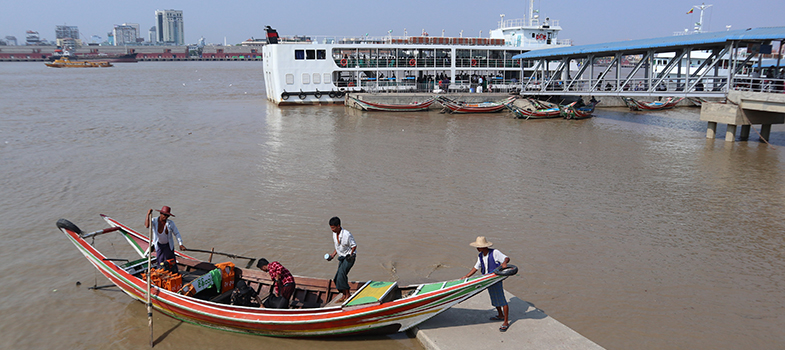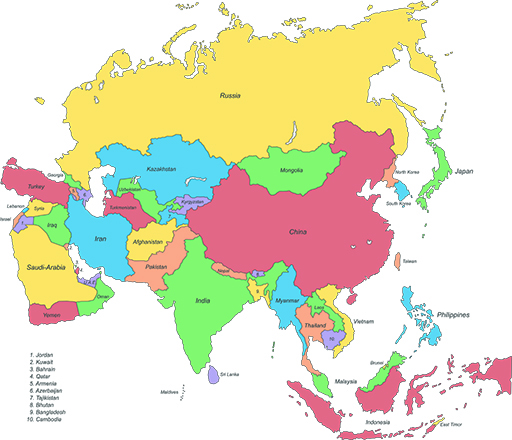2.3 Water resources and uses in Asia
Looking at the regional context, Asia is the largest continent in the world in terms of both area (43.5 million km2) and population (3.5 billion). Travelling clockwise, it borders the Arctic Ocean in the north, the Pacific Ocean in the east, the Indian Ocean in the south, and the Mediterranean Sea in the west.
Asia is notable for high population densities and large settlements, with five of the eight most populous countries in the world, namely China, India, Indonesia, Pakistan and Bangladesh located in Asia (UN DESA, 2015). Asia is also characterised by extremely diverse climatic zones, ranging from arctic conditions in Siberia in the north to tropical ones in Southeast Asia and Southern India.
The distribution of precipitation in the Asia region is extremely varied both geographically and seasonally. Precipitation is abundant on the southern slopes of the Himalayas, the western slopes of the mountains of India and Indochina and the islands of Indonesia, all of which receive from 1,500 mm to in excess of 3,000 mm of rain annually. Annual rainfall near the equator zone is more than 2000 mm, per year. By contrast, almost the entire north-western part of the region is extremely dry, with an annual precipitation of less than 200 mm, and many parts of Southwest and Central Asia have precipitation rates of less than 150 mm per year (Zaisheng et al., 2013).
In the countries bordering the Indian and Pacific Oceans, cyclical monsoon rainfall provides distinctive dry and wet seasons – during the long dry season, temporary water shortages are experienced in many river basins, whilst the wet season is often accompanied by flooding. In absolute terms, the annual renewable water resources are considerable in many developing countries of the region, although not all of this is available for exploitation.
Groundwater resources play an important role in sustaining water needs in Asia. Groundwater is used for crop irrigation, food production, industry, and domestic use, and accounts for about 25% of total water usage in Asia (FAO, 2016). Indeed, the groundwater withdrawal amount in Asia accounts for the majority (72%) of global usage value. This is because Asia has intensive agricultural activities and a large population with high population growth rates (FAO, 2016; Gleeson et al., 2012; Shah, 2005).
Eight out of the ten countries with the largest groundwater extraction are located in Asia – India, China, Nepal, Bangladesh and Pakistan alone account for nearly half of the world’s total groundwater use because of their large populations and intensive agricultural activities. Several countries in Western Asia with no permanent rivers or lakes (Saudi Arabia, United Arab Emirates, Oman, Kuwait, Bahrain, and Qatar) rely on groundwater for almost 100% of their renewable water source.
Groundwater extraction has increased greatly in Asia, particularly since the 1970s. Global estimates on the sustainability of groundwater usage strongly indicate that current groundwater consumption for some regions in Asia, such as the upper Ganges River Basin or North China Plain, is likely to face serious aquifer depletion and water shortage problems (Gleeson et al., 2012).
Groundwater also provides a valuable base flow, supplying water to rivers, lakes, and wetlands, which are distinct ecosystems that are flooded by water, either permanently or seasonally.
Apart from its ecological function, groundwater has significant socio-economic implications. For instance, it was estimated that groundwater irrigation in Asia contributes between US$10 billion and US$30 billion per year to its economy (Shah et al., 2003; WWAP, 2015).
Question 3
a.
Fossil
b.
Rain
c.
Salt
d.
Surface
The correct answer is d.
The social and economic benefits of groundwater are of particular importance to the agricultural activities of Asia. Agriculture is the key to general economic development in many Asian developing countries, providing food security and alleviating poverty. Global estimates suggest that irrigated agriculture accounts for approximately 79% of the total water withdrawals in Asia, which is higher than the global average of 70% (FAO, 2016; WWAP, 2016).
Water use for irrigation activity is also inextricably linked to job creation. Employment rates in the agricultural sector are 39% in Southeast Asia and 44.5% in South and Southwest Asia (ILO, 2014; WWAP 2016). In India, it has been estimated that more than half of the total workforce remains in the agricultural sector (Chand and Parappurathu, 2012).
Some evidence suggests that a causal link exists between the value of economic activity and groundwater abstraction in the major cities of Asia. Consequently, groundwater aids urban growth and its rapid economic development (IGES, 2007).
2.2 Water use globally

